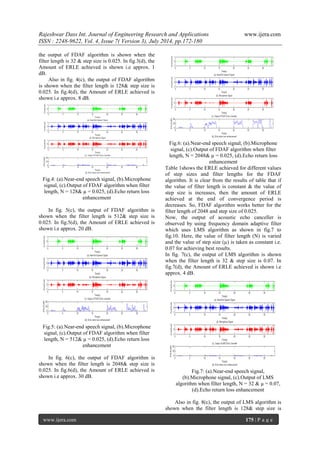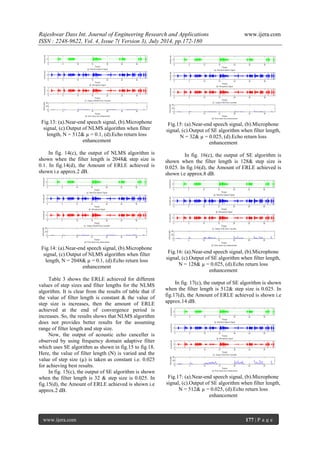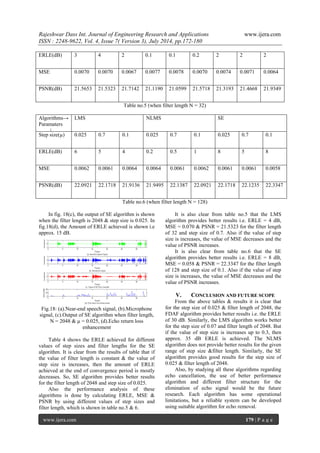The document analyzes various acoustic echo cancellation (AEC) techniques, particularly focusing on frequency domain adaptive filters and their performance metrics, including error rate loss enhancement (ERLE), mean square error (MSE), and peak signal-to-noise ratio (PSNR). It reveals challenges in AEC, such as circuit complexity and convergence speeds, while comparing the efficacy of methods like Least Mean Squares (LMS), Normalized Least Mean Squares (NLMS), and the Sign Error algorithm in different conditions. The findings indicate that frequency domain methods tend to perform better in scenarios with longer impulse responses.
![Rajeshwar Dass Int. Journal of Engineering Research and Applications www.ijera.com
ISSN : 2248-9622, Vol. 4, Issue 7( Version 3), July 2014, pp.172-180
www.ijera.com 172 | P a g e
Performance Analysis of Acoustic Echo Cancellation Techniques Rajeshwar Dass1, Sandeep2 1,2(Department of ECE, D.C.R. University of Science &Technology, Murthal, Sonepat (HR), India) ABSTRACT Mainly, the adaptive filters are implemented in time domain which works efficiently in most of the applications. But in many applications the impulse response becomes too large, which increases the complexity of the adaptive filter beyond a level where it can no longer be implemented efficiently in time domain. An example of where this can happen would be acoustic echo cancellation (AEC) applications. So, there exists an alternative solution i.e. to implement the filters in frequency domain. AEC has so many applications in wide variety of problems in industrial operations, manufacturing and consumer products. Here in this paper, a comparative analysis of different acoustic echo cancellation techniques i.e. Frequency domain adaptive filter (FDAF), Least mean square (LMS), Normalized least mean square (NLMS) &Sign error (SE) is presented. The results are compared with different values of step sizes and the performance of these techniques is measured in terms of Error rate loss enhancement (ERLE), Mean square error (MSE)& Peak signal to noise ratio (PSNR).
Keywords–Acoustic echo cancellation, Error rate loss enhancement, Frequency domain adaptive filtering, Least mean square, Mean square error, Normalized least mean square, Peak signal to noise ratio, Sign error.
I. INTRODUCTION
The term echo cancellation is basically used in a telephony system for describing the process of removing echo from a voice communication system. The history of echo cancellation started from 10th July 1962[1]. Echo cancellation is basically required to improve the call quality, to provide enhanced network performance, for excellent tone rejection, to maintain customer reliability & to provide excellent ERLE performance [1]. There are some challenges which should be kept in mind at the time of designing AEC techniques i.e. circuit complexity, selection of filter length, selection of suitable step size, in finding echo path, different types of noises (acoustic, thermal, DSP related noise) present in circuit, convergence time/speed, computational cost, number of required iterations, computational complexity, residual error and sampling rate [1]. In a telecommunication system, echo can degrades the quality of service. Echo is the repetition of a waveform due to reflection from points where the characteristics of the medium through which the wave propagates changes. In a communication system, echo is generally undesirable but unavoidable [4]. So echo cancellation is an important part of communication system. In an AEC system, as shown in fig.1, a measured microphone signal (d(n)) contains two signals: - the far-end echoed speech signal (x(n)) and the near-end speech signal (v(n)). The aim is to remove the far-end echoed speech signal from the microphone signal using different adaptive filter algorithms, sothat only the near-end speech signal is transmitted. An adaptive filter is a digital filter which adjusts its coefficients to provide the best match to a given desired signal [8].
Fig.1. General Configuration of An Adaptive Echo Cancellor
The remainder of the paper is described as follow: Section 1 briefly describes the basic introduction about echo cancellation. Section 2 describes different types of algorithms/ techniques which are used for acoustic echo cancellation. In section 3, the various performance analysis parameters are presented. In Section 4, the results of
Adaptive Echo Canceller
Echo Path
Σ
Σ
Echo
Far-end echoed speech signal x(n)
Near- end speech signal v(n)
Microphone signal d(n)
Error signal e(n)
푑 (푛)
+
+
+
-
RESEARCH ARTICLE OPEN ACCESS](https://image.slidesharecdn.com/ac04703172180-140909005448-phpapp02/85/Performance-Analysis-of-Acoustic-Echo-Cancellation-Techniques-1-320.jpg)
![Rajeshwar Dass Int. Journal of Engineering Research and Applications www.ijera.com
ISSN : 2248-9622, Vol. 4, Issue 7( Version 3), July 2014, pp.172-180
www.ijera.com 173 | P a g e
different echo cancellation techniques are presented & in section 5, the conclusion and future scope is discussed.
II. AEC TECHNIQUES
In this section, some of the techniques are described which are used for the echo cancellation and these are as follow:
i. FIR frequency domain adaptive filter
The frequency domain adaptive filter used in AEC is very beneficial when the impulse response of the system to be identified is long[2]. In order to compute the output signal and filter updates, this filter uses a fast convolution technique. The main advantage of this kind of filter is that they have improved convergence performance through frequency-bin step size normalization and quickly executes in MATLAB[3]. Generally, the adaptive filters are implemented in time domain which works efficiently for most of the applications[4]. But in many of the applications the impulse response of the filter becomes too large, which increases the complexity of the filter beyond a certain level where it can be no longer implemented effectively in time domain i.e. in AECapplications [5].That is why the filter is implemented in frequency domain. Mainly the Fast Fourier Transform (FFT) and Discrete Fourier Transform (DFT) used for the conversion of signals from time domain to frequency domain[6]. The frequency domain weight vector is defined as[3], W(k) = [푊0 푘 ,……,푊푀−1 푘 ]푇 (1) And the input signal matrix is given as[3], X(k) = diag{푋0(k),……,푋푀−1(푘)}(2) Where diag{.} is an operator which generates a diagonal matrix. The number of elements, M, depends on FDAF configuration (usually M = N or M = 2N). The frequency-domain output vector can be given as the following matrix/vector product[3]: Y(k) = X(k)W(k) (3) and the weight update equation is given as[3], W(k+1) = W(k) + 2Gμ(k)푋퐻(푘)퐸(푘)(4) where superscript H denotes complex conjugate transpose,μ(k) represents the time varying diagonal matrix which contains step sizes,matrix G shows a constraint on gradient푋퐻(푘)퐸(푘)&E(k) is the fourier transform of error matrix e(n), which is computed as, e(n) = d(n) - 푑 (n) This technique has very low computational complexity, faster convergence and consumes less processing power at the same time.
ii. FIR frequency domain adaptive filter with LMS algorithmq
The LMS method is initially proposed by widrow Hoff in 1959[7]. This algorithm adapts to a solution of minimizing mean-square error. This method is based on steepest-descent method. In this, the gradient of mean-squared error is find out with respect to h. If w(n) is the weight vector and x(n) is the input signal of adaptive filter then, output y(n) of the adaptive filter is given by[14] y(n) = 푤(푛)푇x(n) (5) and the error signal e(n) is given by[14], e(n) = d(n)-y(n) (6) and the weight update equation is given by[14], w(n+1) = w(n) + μe(n)x(n) (7) where μ is the step size which controls the convergence rate. If the value of μ is small, then the convergence time is more. So the selection of suitable value of step size is very important[3],[8]. This algorithm is very simple and only requires few numbers of additions and multiplications per iteration for an N-tap filter. It has low computational complexity and the problem of double-talk is removed. But this method takes a fixed value of step size for every iteration [9].
iii. FIR frequency domain adaptive filter with NLMS algorithm
Basically, this algorithm is an extension of LMS. This method achieves faster convergence in time- domain as compared to frequency domain. Also, it has less complexity than LMS algorithm[10],[11]. It uses the weight updation equation as[14], 푤(푛+1) = 푤푛 + μ x(n) x(n) 2e(n) (8) where μ is step size. Here, with the normalization of step size by 푥(푛) 2, the noise amplification problem is diminished but problem occurs when 푥(푛) becomes too small. Therefore, the NLMS algorithm is modified as[14], w(n+1) = wn + μ x(n) ϵ+ x(n) 2e(n) (9) whereퟄ is a small positive number. This converges faster than LMS algorithm because it uses time varying step size calculation, but its computational complexity is high.
iv. FIR frequency domain adaptive filter with Sign-Error algorithm
Here, the sign-error algorithm is used with frequency domain adaptive filter. It is same as the LMS approach with the difference of different convergence time & computational complexity[12],[13]. Also this method provides better results for high value of filter length & for small value of step sizes.
III. PERFORMANCE ANALYSIS PARAMETERS
The various performance parameters which are used here for the performance evaluation of different AEC methods are as follow:](https://image.slidesharecdn.com/ac04703172180-140909005448-phpapp02/85/Performance-Analysis-of-Acoustic-Echo-Cancellation-Techniques-2-320.jpg)
![Rajeshwar Dass Int. Journal of Engineering Research and Applications www.ijera.com
ISSN : 2248-9622, Vol. 4, Issue 7( Version 3), July 2014, pp.172-180
www.ijera.com 174 | P a g e
i. ERLE (Error rate loss enhancement): It is a smoothed measure of the amount (in dB) that the echo has been attenuated. The formula which is used for ERLE is given by[9],
ERLE = 10log10 퐸[푑2 푛 ] 퐸[푒2 푛 ] (10) where d(n) is the far-end echoed signal and e(n) is the residual echo after cancellation.
ii. Mean square error: It contains the sequence of mean-square errors. This column vector contains predictions of the mean-square error of adaptive filter at each time instant.The MSE is calculated as[5],
MSE = 1 푁 푒(푘)2푁푘 =1(11) where N is the filter length and e(k) is the error signal achieved at the output of filter.
iii. Peak signal to noise ratio (PSNR): PSNR computes the peak signal-to-noise ratio, between two signals. This ratio is often used as a quality measurement between the original and the output signal. The higher the PSNR, the better the quality of output signals.The PSNR is calculated as,
PSNR = 10*log10((R*R)/MSE) (12) whereMSE is the value of mean square error and R is the maximum fluctuation in the input signal.
IV. RESULT & DISCUSSIONS
Firstly, the acoustics of the loudspeaker-to- microphone signal path are described where the speakerphone is located. As shown in fig.2(a), a long finite impulse response filter is used to describe these characteristics which generates a random impulse response at a sampling rate of fs = 8000 Hz. The teleconferencing system’s user is mainly located near the system’s microphone which is called as near end speech signal as shown in fig. 2(b). A voice travels out the loudspeaker, bounces around in the room, and this voice is picked up by the system’s microphone; this voice signal is called as far end speech signalas shown in fig.2(c). Also in fig.2(d), the microphone signal contains both the near end speech and the far end speech that has been echoed throughout the room is shown.
Fig.2: (a).Impulse response of room, (b).Near-end speech signal, (c).Far-end echoed speech signal, (d).Microphone signal Output of acoustic echo canceller is observed by using frequency domain adaptive filtering method as shown in fig.3 to fig.6.Here, the value of filter length (N) is varied and the value of step size (μ) is taken as constant i.e. 0.025. The goal of adaptive echo canceller is to remove the far end echoed speech signal, so that only near end speech signal is transmitted back to the far-end listener. Since, we have access to both near end and far end speech signals, so echo return loss enhancement is also calculated, which is the amount (in dB) that how much echo has been attenuated. From fig.6 it has been seen that approx. 30 dB ERLE is achieved at the end of convergence period using FDAF algorithm.
Fig.3: (a).Near-end speech signal, (b).Microphone signal, (c).Output of FDAF algorithm when filter length, N = 32 & μ = 0.025, (d).Echo return loss enhancement
In all the figures from fig.3 to fig.18, (a)&(b) part shows the near-end speech signal and the microphone speech signalrespectively. In fig. 3(c),](https://image.slidesharecdn.com/ac04703172180-140909005448-phpapp02/85/Performance-Analysis-of-Acoustic-Echo-Cancellation-Techniques-3-320.jpg)





![Rajeshwar Dass Int. Journal of Engineering Research and Applications www.ijera.com
ISSN : 2248-9622, Vol. 4, Issue 7( Version 3), July 2014, pp.172-180
www.ijera.com 180 | P a g e
REFERENCES
[1] M. M. Sondhi, “The history of echo cancellation,” IEEE Signal Process Mag., Vol. 23, No.5, Sep. 2006, 95-98. [2] Gerald Enzner, Peter Vary, “A soft- partitioned frequency-domain adaptive filter for acoustic echo cancellation,”Proc. IEEE Conference on Acoustics, Speech and Signal Processing, (ICASSP 2003),Vol. 5, 2003, 393-396. [3] Shynk, J.J., “Frequency-domain and multirate adaptive filtering,” IEEE Signal Processing Magazine, Vol. 9, No. 1, Jan. 1992, 14-37. [4] KoenEneman and Marc Moonen, “Iterated partitioned block frequency-domain adaptive filter for acoustic echo cancellation,” IEEE Transaction on Speech and Audio Processing, Vol. 11, No.2, March 2003. [5] S.Haykin, Adaptive Filter Theory, Prentice Hall, 3rd edition, 1996. [6] Mr. K. G. Gunale, Ms. S. N. Motade, Dr. S. L. Nalbalwar, “Frequency domain adaptive filter using FFT algorithm for acoustic echo cancellation,” Third International Conference on Emerging Trends in Engineering and Technology, IEEE, 2010, 582-587. [7] C. W. K. Griton, D. W. Lin, “Echo cancellation algorithms,” IEEE ASSP Magazine, April 1984. [8] Ms. Mugdha. M. Dewasthale, Dr. R. D. Kharadkar, “Acoustic noise cancellation using adaptive filters: A Survey,”International Conference on Electronic Systems, Signal Processing and Computing Technologies(ICESC), Nagpur , India, Jan. 2014, 12-16. [9] Andrea Fermo, Alberto Carini and Giovanni L. Sicuranza, “Analysys of low complexity nonlinear filters for acoustic echo cancellation,” First International Workshop on Image Signal Processing and Analysis, pula, crotia, June 14-15, 2000. [10] Donald L. Duttweiler, “Proportionate normalized least-mean-squares adaptation in echo cancellers,” IEEE Transactions on Speech and Audio Processing, Vol.8, No.5, Sept 2000. [11] GuduruBhanu Chandra and AbhijitMitra, “A fast adaptive echo canceler with leaky proportionate NLMS algorithm,” IET-UK International Conference on Information and Communication Technology in Electrical Sciences, Dr. M.G.R. university, Chennai, Tamil Nadu, India, Dec. 20-22, 2007, 611-615. [12] Gersho A., "Adaptive Filtering With Binary Reinforcement," IEEE Transactions Information Theory,Vol. IT-30, March 1984, 191-199. [13] Hayes M., Statistical Digital Signal Processing and Modeling, New York, Wiley, 1996. [14] E. Hari Krishna, M Raghuram, K. VenuMadhav and K. AshokaRedd, “Acoustic Echo Cancellation using a Computationally Efficient Transform Domain LMS Adaptive Filter”, 10th International Conference on Information Science, Signal Processing and Their Applications, 2010, 409-412.](https://image.slidesharecdn.com/ac04703172180-140909005448-phpapp02/85/Performance-Analysis-of-Acoustic-Echo-Cancellation-Techniques-9-320.jpg)